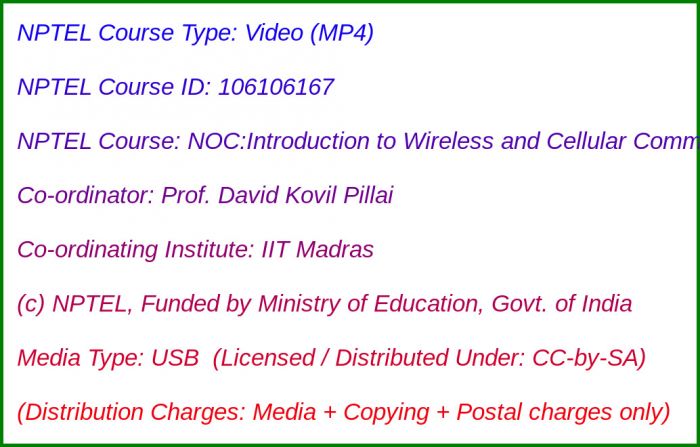NOC:Introduction to Wireless and Cellular Communications (USB)

Media Storage Type : 64 GB USB Stick
NPTEL Subject Matter Expert : Prof. David Kovil Pillai
NPTEL Co-ordinating Institute : IIT Madras
NPTEL Lecture Count : 56
NPTEL Course Size : 40 GB
NPTEL PDF Text Transcription : Available and Included
NPTEL Subtitle Transcription : Available and Included (SRT)
Lecture Titles:
Lecture 1 - Overview of Cellular Systems - Part 1
Lecture 2 - Overview of Cellular Systems - Part 2
Lecture 3 - Overview of Cellular Systems - Part 3
Lecture 4 - 5G and other Wireless Technologies
Lecture 5 - Basic Cellular Terminology
Lecture 6 - Introduction to Antennas and Propagation Models
Lecture 7 - Link budget, Fading margin, Outage
Lecture 8 - Cellular Concept
Lecture 9 - Cellular system design and analysis
Lecture 10 - Cellular Geometry and System Design
Lecture 11 - Cellular System Capacity, Trunking
Lecture 12 - Handoff and Mobility
Lecture 13 - Handoff Part 2, Classification of Signal Variation
Lecture 14 - Shadowing, Outage, Multipath
Lecture 15 - Rayleigh Fading and Statistical Characterization
Lecture 16 - Properties of Rayleigh Distribution
Lecture 17 - BER in Fading, Narrowband vs Wideband Channels
Lecture 18 - Characterization of Multipath Fading Channels
Lecture 19 - Choice of Modulation
Lecture 20 - Coherent versus Differential Detection
Lecture 21 - Review of Lecture 1-19
Lecture 22 - Coherent vs Differential Detection - Part II and BER in Fading
Lecture 23 - BER in Fading - Part II, Ricean Fading
Lecture 24 - Ricean and Nakagami Fading, Moment Generating Function (MGF)
Lecture 25 - MGF Part II, WSSUS Model
Lecture 26 - WSSUS Part II, Coherence Time, Doppler Spectrum
Lecture 27 - Doppler, Temporal Characteristics of Fading Channels
Lecture 28 - WSSUS-Characterization of Time Dispersive Fading Channels
Lecture 29 - WSSUS-Classification of Fading Channels
Lecture 30 - Practical Channel Models (ITU, COST), Computer generation of Rayleigh fading
Lecture 31 - Rayleigh Fading simulation - Clark and Gans Method, Jakes’ Method
Lecture 32 - Jakes’ Method properties
Lecture 33 - Introduction to Diversity, Antenna selection diversity
Lecture 34 - Statistical Characterization of Antenna Diversity, Optimal Diversity Combining
Lecture 35 - BER in fading, Equal Gain Combining
Lecture 36 - Array Gain, Diversity Gain, Alamouti Scheme
Lecture 37 - Alamouti Scheme - Part II, Channel Capacity
Lecture 38 - Capacity of fading Channels, Capacity with Outage
Lecture 39 - Channel State Information, Optimum Power Allocation
Lecture 40
Lecture 41
Lecture 42
Lecture 43
Lecture 44
Lecture 45
Lecture 46 - (Missing)
Lecture 47 - (Missing)
Lecture 48 - Rake Receiver for multipath channels
Lecture 49 - Multiuser environment
Lecture 50 - CDMA system Capacity
Lecture 51 - CDMA Multiuser Detectors - Part 1
Lecture 52 - CDMA Multiuser Detectors - Part 2
Lecture 53
Lecture 54
Lecture 55
Lecture 56

